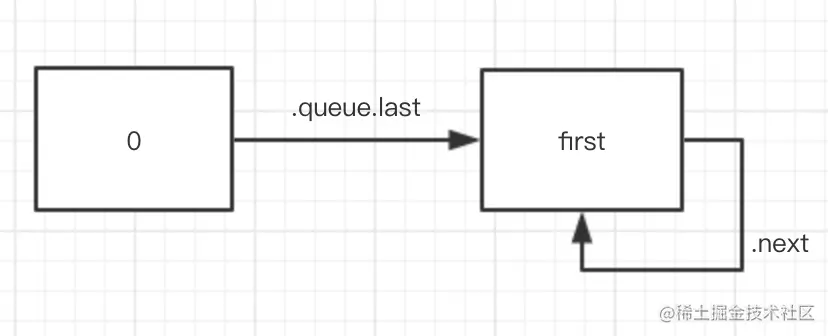react 的 useState 源码分析
作者:flyzz177
- 2022 年 10 月 04 日 浙江
本文字数:4934 字
阅读完需:约 16 分钟
前言
简单说下为什么 React 选择函数式组件,主要是 class 组件比较冗余、生命周期函数写法不友好,骚写法多,functional 组件更符合 React 编程思想等等等。更具体的可以拜读 dan 大神的 blog。其中 Function components capture the rendered values 这句十分精辟的道出函数式组件的优势。
但是在16.8之前react的函数式组件十分羸弱,基本只能作用于纯展示组件,主要因为缺少state和生命周期。本人曾经在hooks出来前负责过纯函数式的react项目,所有状态处理都必须在reducer中进行,所有副作用都在saga中执行,可以说是十分艰辛的经历了。在hooks出来后我在公司的一个小中台项目中使用,落地效果不错,代码量显著减少的同时提升了代码的可读性。因为通过custom hooks可以更好地剥离代码结构,不会像以前类组件那样在cDU等生命周期堆了一大堆逻辑,在命令式代码和声明式代码中有一个良性的边界。
复制代码
useState 在 React 中是怎么实现的
Hooks take some getting used to — and especially at the boundary of imperative and declarative code.
如果对hooks不太了解的可以先看看这篇文章:前情提要,十分简明的介绍了hooks的核心原理,但是我对useEffect,useRef等钩子的实现比较好奇,所以开始啃起了源码,下面我会结合源码介绍useState的原理。useState具体逻辑分成三部分:mountState,dispatch, updateState
复制代码
hook 的结构
首先的是 hooks 的结构,hooks 是挂载在组件 Fiber 结点上 memoizedState 的
//hook的结构export type Hook = { memoizedState: any, //上一次的state baseState: any, //当前state baseUpdate: Update<any, any> | null, // update func queue: UpdateQueue<any, any> | null, //用于缓存多次action next: Hook | null, //链表};
复制代码
renderWithHooks
在 reconciler 中处理函数式组件的函数是 renderWithHooks,其类型是:
renderWithHooks( current: Fiber | null, //当前的fiber结点 workInProgress: Fiber, Component: any, //jsx中用<>调用的函数 props: any, refOrContext: any, nextRenderExpirationTime: ExpirationTime, //需要在什么时候结束): any
复制代码
在 renderWithHooks,核心流程如下:
//从memoizedState中取出hooksnextCurrentHook = current !== null ? current.memoizedState : null; //判断通过有没有hooks判断是mount还是update,两者的函数不同ReactCurrentDispatcher.current = nextCurrentHook === null ? HooksDispatcherOnMount : HooksDispatcherOnUpdate;//执行传入的type函数let children = Component(props, refOrContext);//执行完函数后的dispatcher变成只能调用context的ReactCurrentDispatcher.current = ContextOnlyDispatcher;
return children;
复制代码
相关参考视频讲解:进入学习
useState 构建时流程
mountState
在HooksDispatcherOnMount中,useState调用的是下面的mountState,作用是创建一个新的hook并使用默认值初始化并绑定其触发器,因为useState底层是useReducer,所以数组第二个值返回的是dispatch。
复制代码
type BasicStateAction<S> = (S => S) | S;
function mountState<S>( initialState: (() => S) | S,){ const hook = mountWorkInProgressHook();//如果入参是func则会调用,但是不提供参数,带参数的需要包一层 if (typeof initialState === 'function') { initialState = initialState(); }//上一个state和基本(当前)state都初始化 hook.memoizedState = hook.baseState = initialState; const queue = (hook.queue = { last: null, dispatch: null, eagerReducer: basicStateReducer, // useState使用基础reducer eagerState: (initialState: any), });//返回触发器 const dispatch: Dispatch< //useState底层是useReducer,所以type是BasicStateAction (queue.dispatch = (dispatchAction.bind( null, //绑定当前fiber结点和queue ((currentlyRenderingFiber: any): Fiber), queue, ): any)); return [hook.memoizedState, dispatch];}
复制代码
mountWorkInProgressHook
这个函数是 mountState 时调用的构建 hook 的方法,在初始化完毕后会连接到当前 hook.next(如果有的话)
function mountWorkInProgressHook(): Hook { const hook: Hook = { memoizedState: null, baseState: null, queue: null, baseUpdate: null, next: null, }; if (workInProgressHook === null) { // 列表中的第一个hook firstWorkInProgressHook = workInProgressHook = hook; } else { // 添加到列表的末尾 workInProgressHook = workInProgressHook.next = hook; } return workInProgressHook;}
复制代码
dispatch 分发函数
在上面我们提到,useState底层是useReducer,所以返回的第二个参数是dispatch函数,其中的设计十分巧妙。
复制代码
假设我们有以下代码:
const [data, setData] = React.useState(0)setData('first')setData('second')setData('third')
复制代码

在第一次 setData 后, hooks 的结构如上图

在第二次 setData 后, hooks 的结构如上图

在第三次 setData 后, hooks 的结构如上图

在正常情况下,是不会在dispatcher中触发reducer而是将action存入update中在updateState中再执行,但是如果在react没有重渲染需求的前提下是会提前计算state即eagerState。作为性能优化的一环。
复制代码
function dispatchAction<S, A>( fiber: Fiber, queue: UpdateQueue<S, A>, action: A,) { const alternate = fiber.alternate; { flushPassiveEffects(); //获取当前时间并计算可用时间 const currentTime = requestCurrentTime(); const expirationTime = computeExpirationForFiber(currentTime, fiber);
const update: Update<S, A> = { expirationTime, action, eagerReducer: null, eagerState: null, next: null, }; //下面的代码就是为了构建queue.last是最新的更新,然后last.next开始是每一次的action // 取出last const last = queue.last; if (last === null) { // 自圆 update.next = update; } else { const first = last.next; if (first !== null) {
update.next = first; } last.next = update; } queue.last = update;
if ( fiber.expirationTime === NoWork && (alternate === null || alternate.expirationTime === NoWork) ) { // 当前队列为空,我们可以在进入render阶段前提前计算出下一个状态。如果新的状态和当前状态相同,则可以退出重渲染 const lastRenderedReducer = queue.lastRenderedReducer; // 上次更新完后的reducer if (lastRenderedReducer !== null) { let prevDispatcher; if (__DEV__) { prevDispatcher = ReactCurrentDispatcher.current; // 暂存dispatcher ReactCurrentDispatcher.current = InvalidNestedHooksDispatcherOnUpdateInDEV; } try { const currentState: S = (queue.lastRenderedState: any); // 计算下次state const eagerState = lastRenderedReducer(currentState, action); // 在update对象中存储预计算的完整状态和reducer,如果在进入render阶段前reducer没有变化那么可以服用eagerState而不用重新再次调用reducer update.eagerReducer = lastRenderedReducer; update.eagerState = eagerState; if (is(eagerState, currentState)) { // 在后续的时间中,如果这个组件因别的原因被重渲染且在那时reducer更变后,仍有可能重建这次更新 return; } } catch (error) { // Suppress the error. It will throw again in the render phase. } finally { if (__DEV__) { ReactCurrentDispatcher.current = prevDispatcher; } } } } scheduleWork(fiber, expirationTime); }}
复制代码
useState 更新时流程
updateReducer
因为useState底层是useReducer,所以在更新时的流程(即重渲染组件后)是调用updateReducer的。
复制代码
function updateState<S>( initialState: (() => S) | S,): [S, Dispatch<BasicStateAction<S>>] { return updateReducer(basicStateReducer, (initialState: any));}
复制代码
所以其reducer十分简单
复制代码
function basicStateReducer<S>(state: S, action: BasicStateAction<S>): S { return typeof action === 'function' ? action(state) : action;}
复制代码
我们先把复杂情况抛开,跑通updateReducer流程
复制代码
function updateReducer( reducer: (S, A) => S, initialArg: I, init?: I => S,){ // 获取当前hook,queue const hook = updateWorkInProgressHook(); const queue = hook.queue;
queue.lastRenderedReducer = reducer;
// action队列的最后一个更新 const last = queue.last; // 最后一个更新是基本状态 const baseUpdate = hook.baseUpdate; const baseState = hook.baseState;
// 找到第一个没处理的更新 let first; if (baseUpdate !== null) { if (last !== null) { // 第一次更新时,队列是一个自圆queue.last.next = queue.first。当第一次update提交后,baseUpdate不再为空即可跳出队列 last.next = null; } first = baseUpdate.next; } else { first = last !== null ? last.next : null; } if (first !== null) { let newState = baseState; let newBaseState = null; let newBaseUpdate = null; let prevUpdate = baseUpdate; let update = first; let didSkip = false; do { const updateExpirationTime = update.expirationTime; if (updateExpirationTime < renderExpirationTime) { // 优先级不足,跳过这次更新,如果这是第一次跳过更新,上一个update/state是newBaseupdate/state if (!didSkip) { didSkip = true; newBaseUpdate = prevUpdate; newBaseState = newState; } // 更新优先级 if (updateExpirationTime > remainingExpirationTime) { remainingExpirationTime = updateExpirationTime; } } else { // 处理更新 if (update.eagerReducer === reducer) { // 如果更新被提前处理了且reducer跟当前reducer匹配,可以复用eagerState newState = ((update.eagerState: any): S); } else { // 循环调用reducer const action = update.action; newState = reducer(newState, action); } } prevUpdate = update; update = update.next; } while (update !== null && update !== first);
if (!didSkip) { newBaseUpdate = prevUpdate; newBaseState = newState; }
// 只有在前后state变了才会标记 if (!is(newState, hook.memoizedState)) { markWorkInProgressReceivedUpdate(); } hook.memoizedState = newState; hook.baseUpdate = newBaseUpdate; hook.baseState = newBaseState; queue.lastRenderedState = newState; }
const dispatch: Dispatch<A> = (queue.dispatch: any); return [hook.memoizedState, dispatch];}
复制代码
export function markWorkInProgressReceivedUpdate() { didReceiveUpdate = true;}
复制代码
后记
作为系列的第一篇文章,我选择了最常用的hooks开始,抛开提前计算及与react-reconciler的互动,整个流程是十分清晰易懂的。mount的时候构建钩子,触发dispatch时按序插入update。updateState的时候再按序触发reducer。可以说就是一个简单的redux。
复制代码
划线
评论
复制
发布于: 刚刚阅读数: 3
flyzz177
关注
还未添加个人签名 2021.12.07 加入
还未添加个人简介











评论